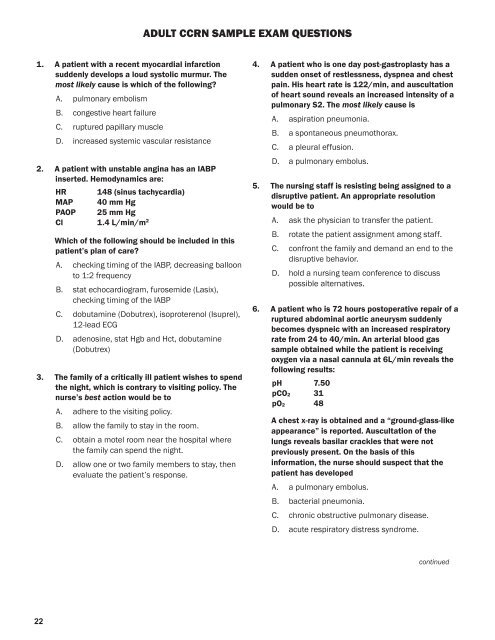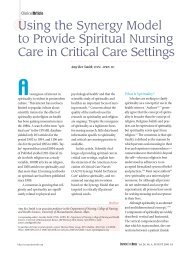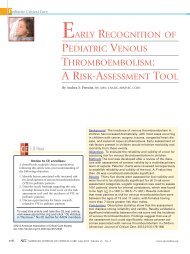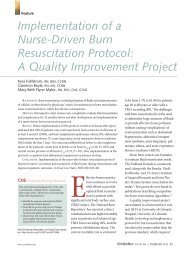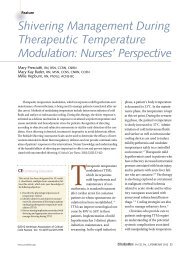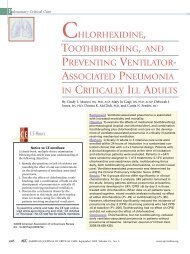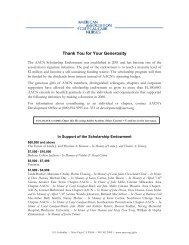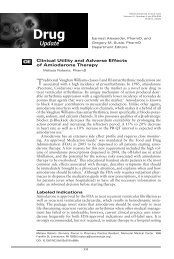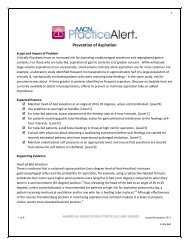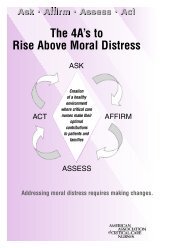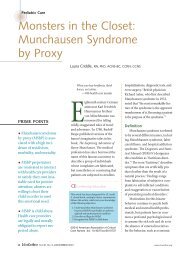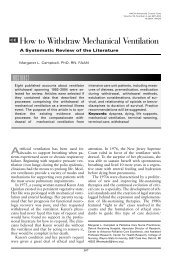CCRN/PCCN Exam Handbook - American Association of Critical ...
CCRN/PCCN Exam Handbook - American Association of Critical ...
CCRN/PCCN Exam Handbook - American Association of Critical ...
Create successful ePaper yourself
Turn your PDF publications into a flip-book with our unique Google optimized e-Paper software.
1. A patient with a recent myocardial infarction<br />
suddenly develops a loud systolic murmur. The<br />
most likely cause is which <strong>of</strong> the following?<br />
a. pulmonary embolism<br />
b. congestive heart failure<br />
C. ruptured papillary muscle<br />
D. increased systemic vascular resistance<br />
2. A patient with unstable angina has an IABP<br />
inserted. Hemodynamics are:<br />
HR 148 (sinus tachycardia)<br />
MAP 40 mm Hg<br />
PAOP 25 mm Hg<br />
Cl 1.4 L/min/m2 22<br />
AdULt CCRn sAMPLe eXAM QUestIons<br />
Which <strong>of</strong> the following should be included in this<br />
patient’s plan <strong>of</strong> care?<br />
a. checking timing <strong>of</strong> the IabP, decreasing balloon<br />
to 1:2 frequency<br />
b. stat echocardiogram, furosemide (Lasix),<br />
checking timing <strong>of</strong> the IabP<br />
C. dobutamine (Dobutrex), isoproterenol (Isuprel),<br />
12-lead eCG<br />
D. adenosine, stat Hgb and Hct, dobutamine<br />
(Dobutrex)<br />
3. The family <strong>of</strong> a critically ill patient wishes to spend<br />
the night, which is contrary to visiting policy. The<br />
nurse’s best action would be to<br />
a. adhere to the visiting policy.<br />
b. allow the family to stay in the room.<br />
C. obtain a motel room near the hospital where<br />
the family can spend the night.<br />
D. allow one or two family members to stay, then<br />
evaluate the patient’s response.<br />
4. A patient who is one day post-gastroplasty has a<br />
sudden onset <strong>of</strong> restlessness, dyspnea and chest<br />
pain. His heart rate is 122/min, and auscultation<br />
<strong>of</strong> heart sound reveals an increased intensity <strong>of</strong> a<br />
pulmonary S2. The most likely cause is<br />
a. aspiration pneumonia.<br />
b. a spontaneous pneumothorax.<br />
C. a pleural effusion.<br />
D. a pulmonary embolus.<br />
5. The nursing staff is resisting being assigned to a<br />
disruptive patient. An appropriate resolution<br />
would be to<br />
a. ask the physician to transfer the patient.<br />
b. rotate the patient assignment among staff.<br />
C. confront the family and demand an end to the<br />
disruptive behavior.<br />
D. hold a nursing team conference to discuss<br />
possible alternatives.<br />
6. A patient who is 72 hours postoperative repair <strong>of</strong> a<br />
ruptured abdominal aortic aneurysm suddenly<br />
becomes dyspneic with an increased respiratory<br />
rate from 24 to 40/min. An arterial blood gas<br />
sample obtained while the patient is receiving<br />
oxygen via a nasal cannula at 6L/min reveals the<br />
following results:<br />
pH 7.50<br />
pCO2 31<br />
pO2 48<br />
A chest x-ray is obtained and a “ground-glass-like<br />
appearance” is reported. Auscultation <strong>of</strong> the<br />
lungs reveals basilar crackles that were not<br />
previously present. On the basis <strong>of</strong> this<br />
information, the nurse should suspect that the<br />
patient has developed<br />
a. a pulmonary embolus.<br />
b. bacterial pneumonia.<br />
C. chronic obstructive pulmonary disease.<br />
D. acute respiratory distress syndrome.<br />
continued


